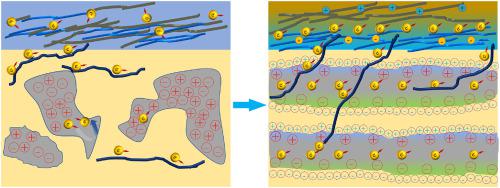Polymer ( IF 4.1 ) Pub Date : 2022-06-20 , DOI: 10.1016/j.polymer.2022.125088 Keqian Gong , Xiangyang Xu , Yanru Liu , Wei Huang , Qi Liu , Xuefeng Huang , Shanshan Wei

|
With polycarbonate (PC)/polyvinylidene fluoride (PVDF) co-continuous matrix as the substrate, composite transparent conductive films with excellent conductive properties were prepared by melt blending and rod coating method. After a surface sulfonation, the conductivity of PVDF films embedded with multi-walled carbon nanotubes (MWCNTs) decreased by three quarters. An ethylene glycol (EG) activated poly(3,4-ethylenedioxythiophene):poly(styrene sulfonate) (PEDOT:PSS) layer was coated on PC/PVDF/MWCNTs to form a continuous and smooth surface, and its conductivity was increased by EG-induced phase separation. Owing to the excellent mechanical strength of PC and the toughing capacity of MWCNTs, the tensile strength of thin PC/PVDF/MWCNTs/PEDOT:PSS film attained 57.49 MPa, almost 3 times that of PVDF. The polymer-polymer or polymer-carbon tubes interaction featured as hydrogen bonding enhance the polarization of PVDF and phase separation of PEDOT:PSS. Meanwhile, sulfonated surface intensified this interaction and improved the lamellar compatibility. The increased PVDF β-phase, the PEDOT:PSS after a thorough phase separation and the well-dispersed carbon tubes all contributed to the densification of the matrix and the homogenized and continuous carrier-transferring property of the composite structure. Exhibiting a transparency surpassing 65%, PC/PVDF/MWCNTs/PEDOT:PSS film possesses a low surface resistivity (33.13 Ω/□). Moreover, owing to well dispersity of components and intensified interfacial bonding, a homogenous conductivity performance can be expected.
中文翻译:

通过 PC/PVDF/MWCNTs/PEDOT:PSS 透明导电薄膜的内部结构调节诱导电极化和电导率均匀化
以聚碳酸酯(PC)/聚偏氟乙烯(PVDF)共连续基体为基材,采用熔融共混和棒涂法制备了具有优异导电性能的复合透明导电薄膜。表面磺化后,嵌入多壁碳纳米管 (MWCNT) 的 PVDF 薄膜的电导率下降了四分之三。将乙二醇 (EG) 活化的聚 (3,4-乙撑二氧噻吩): 聚(苯乙烯磺酸盐) (PEDOT:PSS) 层涂覆在 PC/PVDF/MWCNTs 上,形成连续光滑的表面,EG 提高了其电导率-诱导相分离。由于 PC 优异的机械强度和 MWCNTs 的增韧能力,薄 PC/PVDF/MWCNTs/PEDOT:PSS 薄膜的拉伸强度达到了 57.49 MPa,几乎是 PVDF 的 3 倍。以氢键为特征的聚合物-聚合物或聚合物-碳管相互作用增强了 PVDF 的极化和 PEDOT:PSS 的相分离。同时,磺化表面强化了这种相互作用,提高了层状相容性。增加的 PVDFβ相、经过彻底相分离的PEDOT:PSS和分散良好的碳管均有助于基体的致密化和复合结构的均质化和连续载流子传输性能。PC/PVDF/MWCNTs/PEDOT:PSS 薄膜的透明度超过 65%,具有低表面电阻率(33.13 Ω/□)。此外,由于组分的良好分散性和强化的界面结合,可以预期均匀的导电性能。











































 京公网安备 11010802027423号
京公网安备 11010802027423号